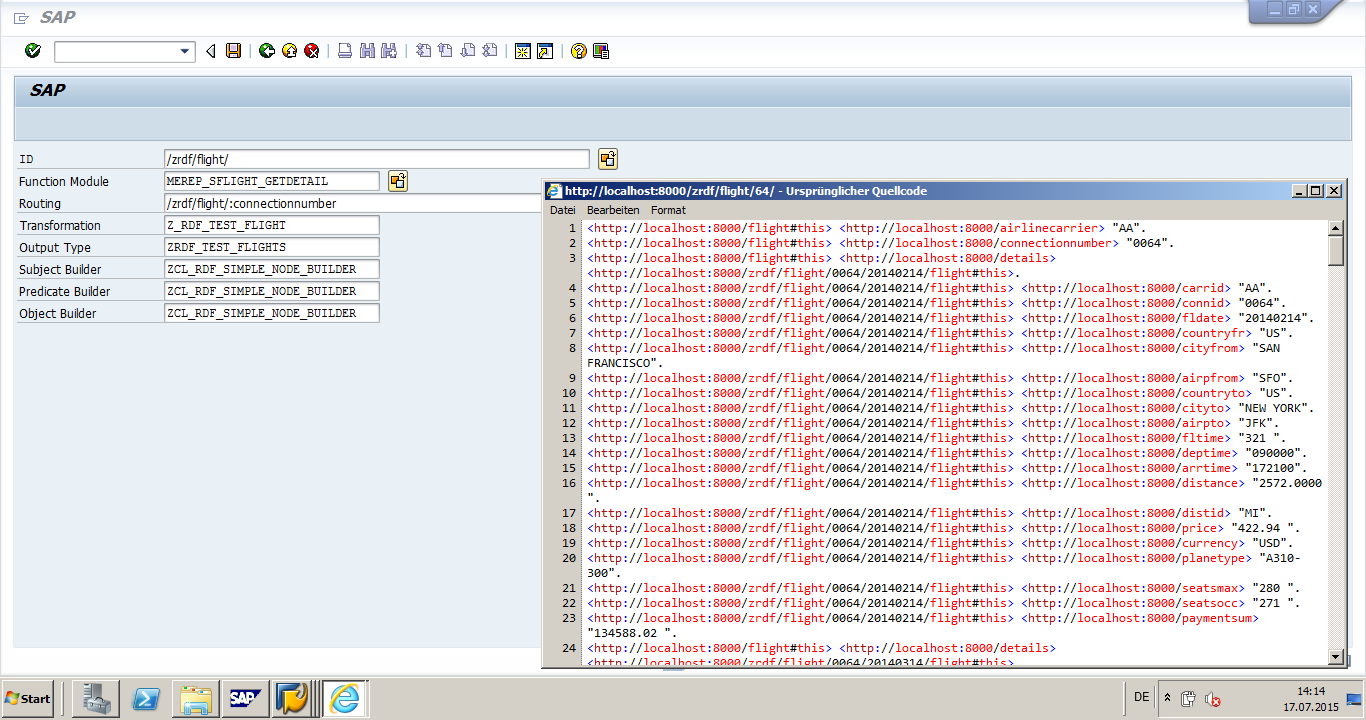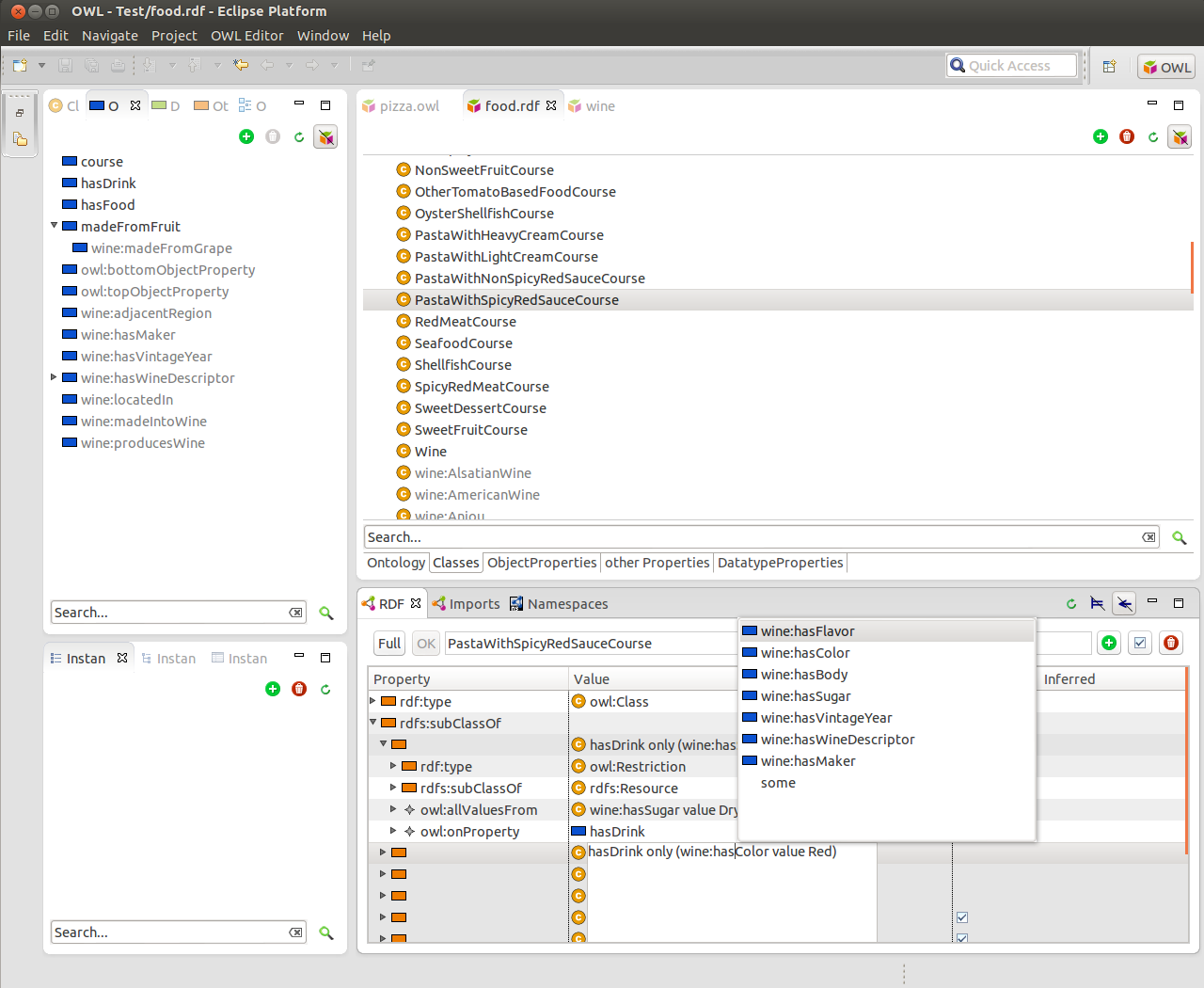See the Fuseki2 documentation.
This page covers Fuseki v1.
Fuseki1 is deprecated and has been retired.
The last release of Jena with this module is Jena 3.9.0.
Fresnel Editor allows the user to visualize RDF data using W3C Fresnel vocabulary. It provides Swing GUI simplifying creation and editing of Fresnel Lenses, Formats and Groups and allows the user to use them to visualize RDF data as XHTML web page. TopBraid Composer™ Maestro Edition (TBC-ME) combines world’s leading semantic web modeling capabilities with the most comprehensive data conversion options and a powerful Integrated Development Environment (IDE) for implementing Knowledge Graph/Linked Data services.
Fuseki is a SPARQL server. It provides REST-style SPARQL HTTP Update, SPARQL Query,and SPARQL Update using the SPARQL protocol over HTTP.
Rdf Editors
The relevant SPARQL standards are:
Contents
Download Fuseki1
Binaries for Fuseki1 are available from themavenrepositories.
The source code is available in the Apache Jena source release.
Getting Started With Fuseki
This section provides a brief guide to getting up and running witha simple server installation. It uses theSOH (SPARQL over HTTP) scripts included in thedownload.
Download the latest
jena-fuseki-*-distributionUnpack the downloaded file with
unziportar zxfvMove into the newly-created
apache-jena-fuseki-*directory(Linux)
chmod +x fuseki-server bin/s-*Run a server
./fuseki-server –update –mem /ds
The server logging goes to the console:
User Interface
The Fuseki download includes a number of services:
- SPARQL Query, SPARQL Update, and file upload to a selecteddataset.
- Link to the documentation (here).
- Validators for SPARQL query and update and for non-RDF/XMLformats.
For the control panel:
- In a browser, go to
http://localhost:3030/ - Click on Control Panel
- Select the dataset (if set up above, there is only one choice).
The page offers SPARQL operations and file upload acting on theselected dataset.
Script Control
In a new window:
Load some RDF data into the default graph of the server:
Get it back:
Query it with SPARQL using the …/query endpoint.
Update it with SPARQL using the …/update endpoint.
Security and Access Control
Fuseki does not currently offer security and access control itself.
Authentication and control of the number of concurrent requests canbe added using an Apache server and either blocking the Fuseki portto outside traffic (e.g. on Amazon’s EC2) or by listening only thelocalhost network interface. This is especially important for updateendpoints (SPARQL Update, SPARQL Graph Store protocol withPUT/POST/DELETE enabled).
Data can be updated without access control if the server is startedwith the --update argument. If started without that argument, datais read-only.
Logging
Fuseki usesLog4Jfor logging. There are two main logging channels:
- The general server messages:
org.apache.jena.fuseki.Server - A channel for all request messages:
org.apache.jena.fuseki.Fuseki
The default settings are (this is an extract of a log4j propertiesfile):
Server URI scheme
This details the service URIs for Fuseki:
http://*host*/dataset/query– the SPARQL query endpoint.http://*host*/dataset/update– the SPARQL Update languageendpoint.http://*host*/dataset/data– the SPARQL Graph Store Protocolendpoint.http://*host*/dataset/upload– the file upload endpoint.
Where dataset is a URI path. Note that Fuseki defaults to usingport 3030 so host is often localhost:3030.
Important - While you may set dataset to be the text dataset this should be avoided since it may interfere with the function of the control panel and web pages.
The URIhttp://host/dataset/sparqlis currently mapped to /query but this may change to being ageneral purpose SPARQL query endpoint.
Running a Fuseki Server
The server can be run with the script fuseki-server. Common formsare:
There is an option --port=PORT to set the port number. Itdefaults to 3030.
/DatasetPathName is the name under which the dataset will beaccessible over HTTP. Please see the above section on Server URI scheme for notes regarding available URIs and choice of this name
The server will service read requests only unless the --updateargument is used.
The full choice of dataset forms is:
Fuseki Dataset Descriptions
--mem
Create an empty, in-memory (non-persistent) dataset.--file=FILE
Create an empty, in-memory (non-persistent) dataset, then load FILEinto it.--loc=DIR
Use an existing TDB database. Create an empty one if it does notexist.--desc=assemblerFile
Construct a dataset based on the general assembler description.--config=ConfigFile
Construct one or more service endpoints based on theconfiguration description.
A copy of TDB is included in the standalone server. An exampleassembler file for TDB is in tdb.ttl.
Fuseki Server Arguments
--help
Print help message.--port=*number*
Run on port number (default is 3030).--localhost
Listen only to the localhost network interface.--update
Allow update. Otherwise only read requests are served (ignored if a configuration file is given).
Fuseki Server starting with an empty dataset
runs the server on port 3030 with an in-memory dataset. It can beaccessed via the appropriate protocol at the following URLs:
- SPARQL query:
http://localhost:3030/ds/query - SPARQL update:
http://localhost:3030/ds/update - SPARQL HTTP update:
http://localhost:3030/ds/data
The SPARQL Over HTTP scripts take care of namingand protocol details. For example, to load in a file data.rdf:
Fuseki Server and TDB
Fuseki includes a built-in version of TDB. Run the server with the--desc argument
and a database in the directory DB, an assembler description of:
The form:
is a shorthand for such an assembler with location DB.
To make triples from all the named graphs appear as the default,unnamed graph, use:
Fuseki Server and general dataset descriptions
The Fuseki server can be given anassembler descriptionto build a variety of model and datasets types.
Full details of setting up models assembler is given in theassembler documentation and assembler howto.
Rdf Editor Tool
A general dataset is described by:
The models can beJena inference models.
Fuseki Configuration File
A Fuseki server can be set up using a configuration file. Thecommand-line arguments for publishing a single dataset are a shortcut that, internally, builds a default configuration based on thedataset name given.
The configuration is an RDF graph. One graph consists of one serverdescription, with a number of services, and each service offers anumber of endpoints over a dataset.
The example below is all one file (RDF graph in Turtle syntax)split to allow for commentary.
Prefix declarations
Some useful prefix declarations:
Server Section
Order of the file does not matter to the machine, but it’s usefulto start with the server description, then each of the serviceswith its datasets.
Assembler Initialization
All datasets are described byassembler descriptions.Assemblers provide an extensible way of describing many kinds ofobjects. Set up any assembler extensions - here, the TDB assemblersupport.
Service 1

This service offers SPARQL Query, SPARQL Update and SPARQL GraphStore protocol, as well as file upload, on an in-memory dataset.Initially, the dataset is empty.
Service 2
This service offers a number of endpoints. It is read-only, becauseonly read-only endpoints are defined (SPARQL Query and HTTP GETSPARQl Graph Store protocol). The dataset is a single in-memorygraph:
This service offers read-only access to a dataset with a singlegraph of data.
Service 3
This service offers SPARQL query access only to a TDB database. TheTDB database can have specific features set, such as query timeoutor making the default graph the union of all named graphs.
SPARQL Over HTTP
SOH (SPARQL Over HTTP) is a set of command-line scripts forworking with SPARQL 1.1. SOH is server-independent and will workwith any compliant SPARQL 1.1 system offering HTTP access.
See the SPARQL Over HTTP page.
Examples
Use from Java
SPARQL Query
ARQ’s QueryExecutionFactory.sparqlService can be used.
SPARQL Update
See UpdateExecutionFactory.createRemote
SPARQL HTTP
See DatasetAccessor
Done!
Done! The edited document is now ready for download.
We Care About Your Privacy
All your documents & images uploaded to our server will be deleted after some time. Hence, nobody can access your files and data, and we can guarantee you that your privacy will be safe. We take privacy very seriously.
Absolutely Free PDF Editor
Our PDF editor comes with many prebuild tools and features. Like adding Text onto files. All of these features are free for everyone to use. There's also no limit on the number of usage as well.
Works on All Platforms
Whether it be Windows, Linus or MacOS. Our software works on all of these different operating systems.
A PDF API for Developers
We have even developed API for developers so that they can use our tools on their own websites and domains as well.
Various Editing Tools
Users can click on Text button to add content. Users can even draw shapes by clicking on the Shapes button and also add images. These three things form the building blocks of all PDF documents.

Cloud Based System
All of these features are completely online. This means that any can edit their PDF files from anywhere. Previously, people had to purchase & download software to access these features.
Difference between Online and Desktop PDF Editors
Online Editor
- Long-time wait
- Up to 10MB file size*
- Can't edit existing content in PDF
- Add texts, images and shapes
- Slow conversion speed
- Basic OCR feature (Pro)
Desktop Editor
- 0 second wait
- No size limits
- Edit existing content in PDF
- Add Watermarks, Backgrounds, Headers and Footers
- Create fillable PDF forms
- Limitless batch conversion mode integrated
- 6X faster conversion speed
- Powerful full-text OCR integrated
* HiPDF Pro subscribers enjoy much larger upload volumes for each file.
How to Edit PDF with PDFelement Pro
- 01
Open your PDF file in PDFelement Pro
Click on the 'Open File' button to select PDF file from your device or simply drag-and-drop the file into the program.
- 02
Edit PDF text
Go to the 'Edit' tab and you'll find a complete toolset to edit your PDF document. To edit text, you just need to click the 'Edit' button to open the editing mode (you can switch between two different editing modes: 'Line Mode' and 'Paragraph Mode' ), then you can edit any piece of text in the document by tapping on the place where you want to edit. You can also edit the font size and color of the text with ease.

- 03
Edit PDF images
Click the 'Edit' button to enter editing mode, click the image to select it, then you will find more tools on the right hand panel such as 'Rotate', 'Flip', 'Align' and 'Crop'. You can also right-click on the image and find these options from the context menu.
To move an image, you can just drag it to the desired location.To resize an image, you can select it then drag a corner. To retain the original aspect ratio, please hold the Shift key and then drag the corner.
- 04
Edit PDF pages
To organize PDF pages, please go to 'Page' menu. There are many features, such as insert pages, delete pages, crop pages, split pages, extract pages and rotate pages. Feel free to manipulate PDF pages the way you need it.
HiPDF's online editing features are limited on adding texts, images or shapes, as well as annotations and signatures. If you need to edit the existing content in the original PDF file (interactive editing), please feel free to try our desktop software - PDFelement Pro.
Rdf Editor Free
Key Features
Rdf Editor Free
Edit text, images, links and pages
Edit watermarks, backgrounds, headers and footers
Annotate PDFs: including highlight, strikeout, underline, sticky notes, comments, stamps, text boxes and personalized drawing tools.
Protect PDFs. Encrypt, redact, and sign PDFs.
OCR ( Edit a scanned PDF file)
Video: The Best Online PDF editor - PDFelement Pro
Convert from PDF